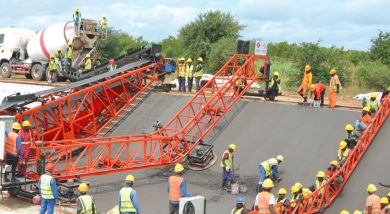Sadc slow adoption of pit farming
Josephy Mwasiya from Luniya Village, Traditional Authority (T/A) Chigaru in Blantyre wakes up at dusk to dig pits in his maize field.
The village, blossoming with with cattle farming, lies in the rain shadow area of Southern Malawi which extends to some parts of Neno, Mwanza, Balaka and Mangochi districts
With climate change, Mwasiya says episodes of drought have worsened and caused him to adopt pit farming also known as Pfumvudza in Zimbabwe and Zai in Burkina Faso and other countries.
The 59-year-old subsistent farmer says since he adopted the agricultural technology five years ago and he has never looked back.
The father of five says: “I have been doing this for five years now and I always get bumper yields.
“Before I embraced this technology, I used to harvest two ox-carts full of maize, but these days I get five from the same piece of land,” he says.
Another farmer, Brian Khumbanyiwa, from Masangano Village, T/A Kuntaja in Blantyre agrees that pit farming is “a deal”.
“With frequent and extended dry spells in this area, I decided to adopt this technology and it has never failed. The yields are always high,” he says.
Even with prolonged mid-season dry spells, they claim they do not suffer much loss.
A study by the Agricultural Technology Adoption Initiative (ATAI) entitled Making Networks Work for Policy: Evidence from Agricultural Technology Adoption in Malawi confirms that pit planting boosts agricultural productivity.

The study was done by Northwestern economics professor Lori Beaman, University of California associate professor of agricultural and resource economics Jeremy Magruder and Ariel BenYishay, an associate professor of economics at the William and Mary.
Climate Change
Climate change, according to United Nations Framework Convention on Climate Change, is a change of climate which is attributed directly or indirectly to human activity that alters the composition of the global atmosphere and which is in addition to natural climate variability observed over comparable time periods.
Climate change in Sadc
Malawi University of Business and Applied Sciences economics professor Betchani Tchereni says climate change presents a mammoth challenge to the socio-economic growth of the Sadc region whose economies are agro-based.
Sadc Climate Change Strategy and Action Plan underscore the importance of agriculture in the region, saying 70 percent of its population depends on agriculture for food, income and employment.
Reads the strategy in part: “Agriculture is a major social and economic sector in the Sadc region, contributing between 4 percent and 27 percent of GDP and approximately 13 percent of overall export earnings.”
Tchereni fears if left unchecked, climate change has the potential to derail Sadc’s goals of achieving economic development, peace and security, alleviating poverty and enhancing the standard of life for its people.
His fears resonate with the strategy which reads: “In 2001 and 2002, for example, Lesotho, Malawi, Mozambique, Swaziland, Zambia and Zimbabwe faced a food deficit of about 1.2 million tonnes of cereals and non-food requirements, estimated to cost $611 million.”
In response, Sadc has come up with a number of frameworks to mitigate climate change, including its blueprint the Regional Indicative Development Plan.
For example, Information Brief: Agriculture in the Sadc Region Under Climate Change singles out Zai pits as a way of harvesting rain water and concentrating compost manure.
The member States have been encouraging their farmers to follow conservation agriculture, including pit farming.
In Zimbabwe, for example, Foundations for Farming (FFF) champions Pfumvudza and the results have been phenomenal—bush fires have been reduced because farmers, apart from making pits, they also use plant residues to cover their fields to reduce evaporation and erosion.
FFF also encourages farmers to practise crop rotation not only to break cycles of diseases and pests commonly associated with climate change, but also to improve soil fertility and structure.
A study by Mercy Kebenei, Monica Mucheru-Muna and Felista Muriu-Nganga entitled The Potential of Zai Pit Technology and Integrated Soil Fertility Management to Enhance Crop Productivity in Semi-Arid Regions of Sub-Sahara Africa’ shows that pit farming is practised across the Sub-Saharan Africa.
Pit farming
Pit farming involves clearing land and digging hoe-size pits, 25 centimetres (cm) apart and with the depth of about 12cm or 15cm in rows of 75cm apart.
“That done, we put one maize seed per hole to reduce plants from competing for air, water, nutrients and sunshine,” says Antonie Suwedi, a farmer from Nyoka Village, T/A Nyoka in Mchinji District.
The measurements seem to differ from one country to another.
In Zimbabwe, for instance, most farmers put two seeds per plant station of 50cm or 60cm apart, with row spacing of 75cm.
Pit farming is suitable in areas that receive low rainfall like some parts of Blantyre, Chikwawa, Neno, Mwanza, Balaka and Mangochi.
In high rainfall areas such as Mulanje, Nkhata Bay and Chitipa, experts say pits may cause water logging, resulting in crop failure.
The technology, according to Eco-Community, is suitable for growing maize, onions, tomatoes, millets, sorghum and several others.
Benefits
Although labour intensive at the beginning, Sewedi says planting in pits offers many benefits.
“This technology reduces run-off and allows water to enter the ground after a downpour and in so doing, soil erosion is reduced. It is the best way of harvesting rain water at a smallholder farmer level”.
Lilongwe University of Agriculture and Natural Resources soil scientist Dr Patson Nalivata adds that pit farming is one of the ways of harvesting rain water.
“When it rains, water is trapped in pits, making it available to plant roots a little longer than in traditional farming systems. This is why plants under this agricultural technology look healthy even after days of no rain.
Several studies show that pit farming is also the best way of managing soil fertility since organic or inorganic fertilisers are applied in pits and they are rarely washed by rain water.
Adoption
The ATAI study shows low adoption pit farming in Southern Africa.
“Many farmers in sub-Saharan Africa are reluctant to adopt productivity-enhancing technologies because they lack persuasive information on the proper use of new inputs or agricultural techniques from credible sources,” reads the study.
“While pit planting has shown to greatly improve maize yields……only 0.2 percent of farmers in the study reported planting with pits in the year prior to the evaluation,” reads the study in part.
World Bank report titled Working with Smallholders: A Handbook for Firms Building Sustainable Supply Chains also weighs in on low technology adoption in developing countries.
“Non-adoption may occur when farmers are not sufficiently convinced that new practices will benefit them or when they cannot afford the new practices,” reads the report.
Mwasiya, who chairs Nzeru N’chuma Farm Club, agrees: “Alimi ambiri safuna ulimi wa m’maenje kaamba koti umapatsa chintchito cholemetsa [some farmers are reluctant to adopt this technology because it is laborious].”
The ATAI study suggests the use of lead farmers and extension workers to increase diffusion of technologies among farmers.
Ironically, most governments in the region are reluctant to increase their agricultural budgets in line with the Comprehensive Africa Agriculture Development Programme(CAADP)which would enable them to boost extension services.
National Smallholder Farmers Association of Malawi (Nasfam) policy and communications head Rejoice Chikakuda argues that “to make matters worse large chunks of agriculture budgets go to farm input subsidy programmes at the expense of extension service budgets”.
Nasfam in partnership with ActionAid Malawi, Nation Publications Limited, Tiphedzane Community Support Organisation, Mudziwathu Community Radio, Nyamthepa Community Radio and African Brief have been running a Partnership for Social Accountability Project to lobby the Malawi Parliament to increase agriculture budget in line with CAADP.
Similar efforts are being implemented in Zambia, Zimbabwe, Mozambique, Tanzania and South Africa.
Diffusion of Innovation Theory
In 1962, Everett Rogers explained how people adopt new ideas and came up with Diffusion of Innovation Theory.
According to the theory, some people are risk takers and ready to try new ideas while others sit on the fences to see how the new technology would work in real life.
Depending on how early one adopts a technology, Roger came up with five stages—innovators, early adopters, early majority, late majority and sluggards.
The World Bank’s study seems to validate Rogers’ stages of technology adoption, arguing that many farmers in developing countries do not how enthusiasm to adopt an agricultural technology unless they are convinced that it cost-effective and beneficial.
Conclusion
Climate change is here and wreaking havoc in the Sadc region. Sadc member States should, therefore, rise to the occasion by encouraging large scale-adoption of climate smart agricultural technologies such as pit farming.






One Comment